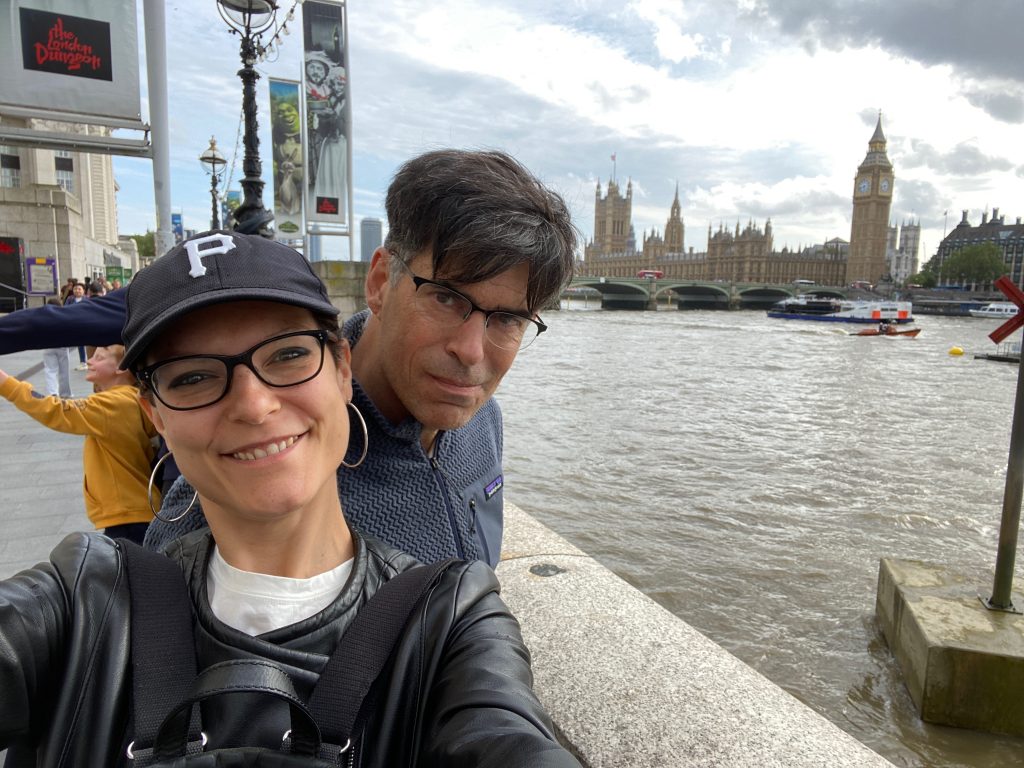Contemporary European design can provide an effective roadmap for architects in the United States. Preserving the past while embracing innovation and reinvention, it IS possible to respect old buildings while at the same time designing new buildings with technologies, aesthetics, and green building techniques that respond to the way we live NOW.
Introduction
This summer, Bea and I have taken another deep dive into European culture. At the moment, we’re plugged into our Italian office in the tiny “frazione” of Almanno high up in the Alps. Our main street here is an old stone path called a “mulattiera”. It’s literally a mule path. Just this morning a young woman walked a horse past our front door. Last night we awoke in the middle of the night to the sound of a loud chomping noise that sounded like someone was cracking walnuts at our bedroom window. We looked outside and, with the aid of an iphone flashlight, spied the biggest deer either one of us had ever seen feasting on our neighbor’s lilies.
The buildings in Almanno are all old – really old – with stone walls and tiled roofs. The two of us have written a lot about the power of old buildings and why they deserve to be saved, even those that may not have been built by wealthy folk. We often talk about creating an architecture where “Old Meets New”[1], one where old and new buildings can coexist like happy neighbors.
You may have heard us use the word, “palimpsest”, which refers to a parchment on which partially erased previously written layers are still visible. Our thought is that this kind of architecture is like a palimpsest[2] because it too can be read as a series of layers. A viewer notices that first one thing was built, and then another. “Old meets New” architecture has the virtue of exhibiting the fourth dimension of time in addition to the three dimensions we normally experience. It’s cool stuff for sure.
From Pittsburgh to Europe!
At the start of our trip abroad this year we visited three GORGEOUS European cities in ten days; London, Utrecht, and Milan. There we saw many amazing examples of architecture and urbanism from different places and times. Although I may be writing from Almanno, Bea and I feel that it is important for us to also keep our finger on the pulse of CITY architecture because today more than eighty percent of U.S. residents live in metropolitan areas.[3] Also, it should be noted that our home office is located near the center of Pittsburgh, the fine mid-Atlantic we call home, and most of our clients live within a couple miles of us. We breathe city air ten months a year…
Designing NEW (without cognitive dissonance)
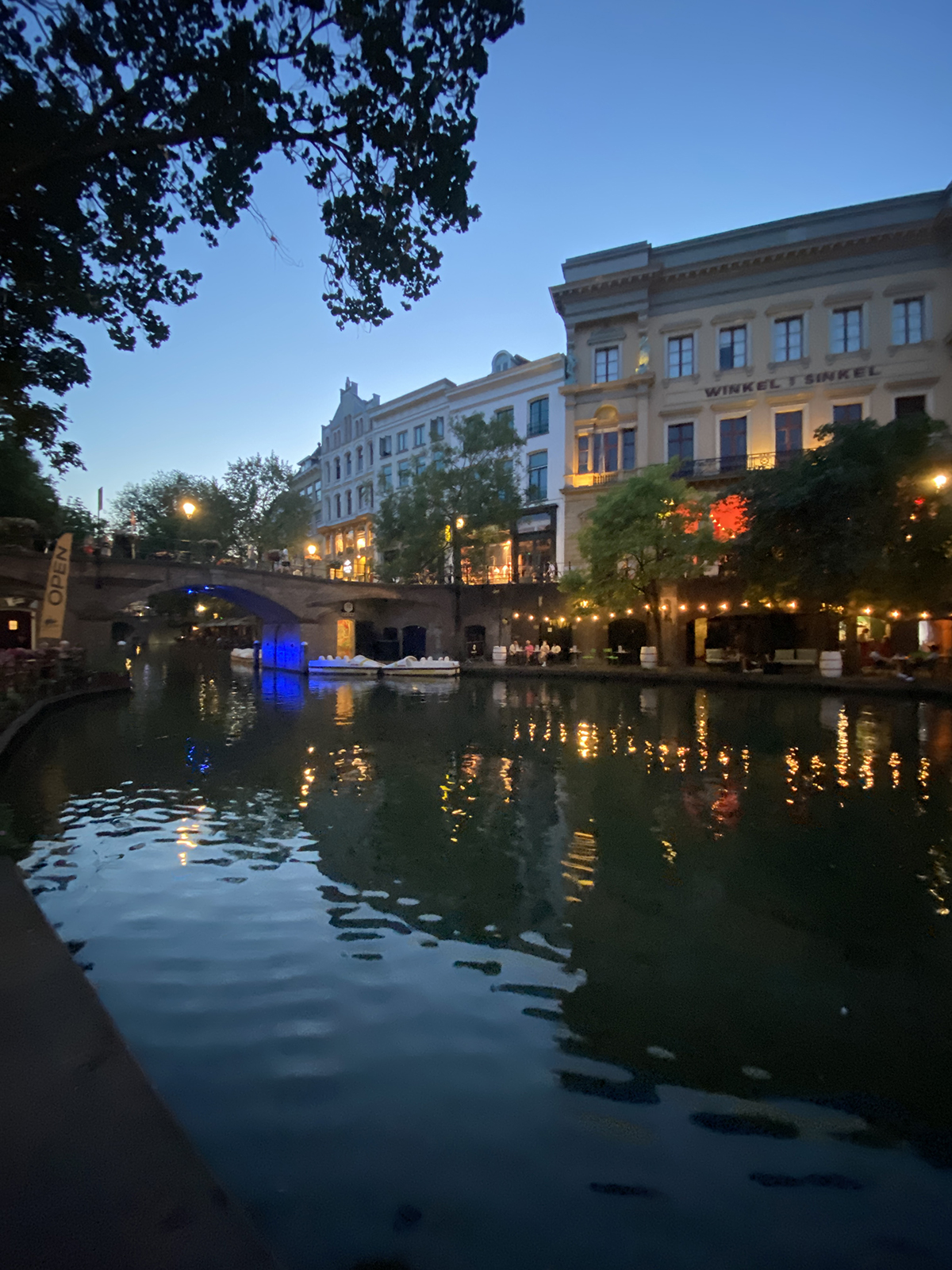 This Summer, we are taking a deep dive into the NEW part of “Old meets New”: Progressive, modern buildings are going up in every European city despite the historic nature of their city centers. It is impossible not to imagine how Pittsburgh could use European examples as it moves ahead, preserving the past while embracing innovation and reinvention. Bea and I feel it is possible to respect old buildings while at the same time designing new buildings with technologies, aesthetics, and green building techniques that respond to the way we live NOW.
This Summer, we are taking a deep dive into the NEW part of “Old meets New”: Progressive, modern buildings are going up in every European city despite the historic nature of their city centers. It is impossible not to imagine how Pittsburgh could use European examples as it moves ahead, preserving the past while embracing innovation and reinvention. Bea and I feel it is possible to respect old buildings while at the same time designing new buildings with technologies, aesthetics, and green building techniques that respond to the way we live NOW.
These are not contradictory concepts. It is possible to be, as one Pittsburgh writer described us, “unabashed Modernists” AND still be rigorous preservationists.
What recently constructed works of architecture have Bea and I seen since our arrival in Europe this year that have inspired us? Here’s a short list with clickable links to discover more:
London
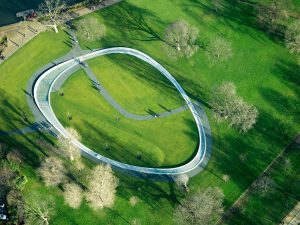
- The London cable car: A gondola in London that crosses the River Thames. (Let’s connect the UPMC tower to the Warhol!)
- The Diana Memorial Fountain: This interactive monument by Gustafson Porter + Bowman is, in essence, an organic, landscaped water necklace that celebrates the life of a remarkable British princess .
- The “Now Building” by Outernet Global. The building itself is quite nice; but the entry court is mind blowing, with interactive LED clad walls and a roof featuring a constantly shifting mix of digital experiences that are by turn fantastic and surreal.
Designing New – Utrecht
- “15-minute cities[4]” ARE possible! As Bea and I walked around, it seemed to us that Utrecht was essentially a big park dotted with buildings, proving the idea that it is possible to live, play, and work in an urban area without a car.
- Life on the canals and rivers is an essential part of Dutch life (Hello Pittsburgh?!?!)
- The Rietveld Schröder House: A hundred year “young” home, designed in a manner that looked like nothing that had EVER existed before. It must have knocked people’s bonnets off.
Designing New – Milan
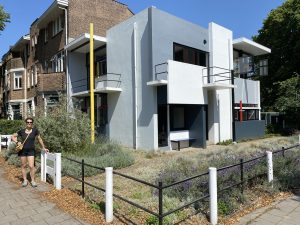
- The Armani Silos: Giorgio Armani’s favorite architect, Tadao Ando, designed this austere, minimal museum within the shell of a former Nestle headquarters. But the architecture takes a back seat to Armani’s uniquely crafted dresses, masterpieces that speak above all to the importance of design quality and craftsmanship
- The Vertical Forest: No visit to Milan by an architect is complete without a visit to this sustainable wonder, a model of “vertical densification of nature within the city[5]”
- The Milan Metro Using the subway (or buses) doesn’t have to be inconvenient. Also, the stations are beautiful. Why wouldn’t they be: Franco Albini designed the oldest lines, with signage by Bob Noorda. And remarkably, new lines to Linate and San Siro Stadium have just opened.
NEW Buildings in the Future
The weather has been crazy here in Europe the last couple years, just like in the US. Two years ago, we had flooding in the alps. Our mulattiera – remember that word? – was a river. Last year it didn’t rain all summer. This year has been the hottest Milan has ever had. Just last week, hail the size of tennis balls dented every uncovered car in the city. “Pazzo” indeed…
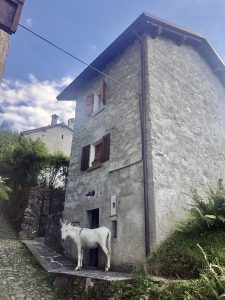
There’s no single building technique that can totally protect folks from the effects of climate change. However, in Italy, where most homes don’t have air conditioning though palm trees now line the edges of the Piazza del Duomo, locals have long put to use sustainable building techniques. According to a recent article in the New York Times,
“Those features, which include courtyards, heavy shutters, reflective painting and white-stone facades, can keep homes cool naturally and reduce the need for air-conditioning. The problem, particularly for Mediterranean cities that have endured scorching temperatures this summer, is that many newer buildings have been built using Western styles that trap heat,” said Marialena Nikolopoulou, a professor of sustainable architecture at the University of Kent in England.[6]
Almanno
The walls of our small Almanno home, which are two feet thick with small, shuttered windows, keep us comfortable through hot summer nights, just like the Vertical Forest but at a fraction of the cost.
Air conditioning, which already accounts for nearly ten percent of all global greenhouse emissions[7], may become increasingly necessary in the future, but it is not a solution for global warming. A better strategy is for new buildings, like the ones we admire, to put to use both new technologies and old ones.
Developers will continue to construct New buildings. And they should build them because old buildings can’t serve all our needs. Bea and I are big fans of new buildings WHEN they are necessary. However, today’s weather doesn’t suit most twentieth century US buildings. A revolution needs to occur within the American building industry for it to truly serve our needs. In my opinion, and also Bea’s, contemporary European design can provide an effective roadmap for negotiating the perils we are sure to soon face…
[2] https://fisherarch.com/phlf-lecture/
[3] https://www.prb.org/resources/u-s-megalopolises-50-years-later/
[4] The 15-minute city (FMC or 15mC)[1][2][3][4] is an urban planning concept in which inhabitants can easily reach most daily necessities and services, such as work, shopping, education, healthcare, and leisure by a 15-minute walk or bike ride from any point in the city.[5]
[5] https://urbannext.net/vertical-forest/
[6] https://www.nytimes.com/2023/07/28/world/europe/europe-heat-buildings-air-conditioning

